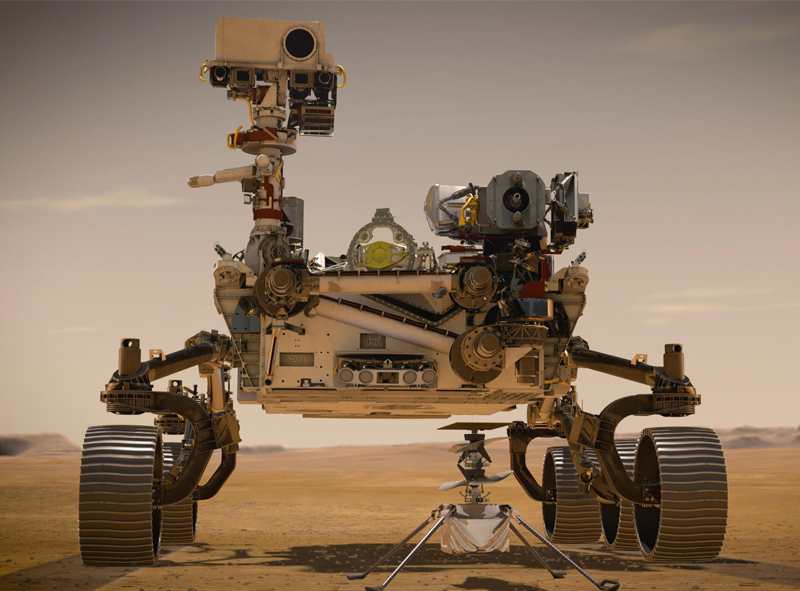 On February 18, humankind witnessed another huge step into the solar system. NASA's Perseverance rover, 6 1/2 months after leaving an Earth gripped by a worldwide pandemic, touched down on an unknown portion of Martian terrain. Now, it is expected to hit a new milestone this week. The new robotic addition to Mars is the product of years of hard work and holds the hopes and dreams of millions – why else would 10.9 million people sign up to have their names physically sent aboard the rover?
On February 18, humankind witnessed another huge step into the solar system. NASA's Perseverance rover, 6 1/2 months after leaving an Earth gripped by a worldwide pandemic, touched down on an unknown portion of Martian terrain. Now, it is expected to hit a new milestone this week. The new robotic addition to Mars is the product of years of hard work and holds the hopes and dreams of millions – why else would 10.9 million people sign up to have their names physically sent aboard the rover?
Perseverance’s technology will provide researchers with much-needed data on Mars's past, present, and future. Not only is the rover equipped to search for biosignatures of past microbial life and measure the planet’s current climate, but its myriad sensors will help chart the course for future human missions to the Moon, Mars, and beyond.
That’s not all Perseverance offers, however. Perseverance also brought with it a small helicopter known as Ingenuity, which will attempt the first powered flight on another planet. According to NASA, Ingenuity’s singular mission is to conduct flight tests in the thin atmosphere of Mars – it carries no scientific instruments. Having moved out to a designated area chosen for its flatness and lack of obstructions, it will attempt its first lift off as soon as April 11. Ingenuity’s tests are expected to last for 30 Martian days, after which Perseverance’s exploration of Jezero Crater will begin.
Charles Bolden, who is a former NASA Administrator under President Obama and a member of the Potomac Institute Board of Regents, said this mission could be the last step before sending humans to Mars. “I’m really excited about Perseverance because it's going to give us an opportunity conduct such experiments as taking carbon dioxide out of the Martian atmosphere in order to extract breathable oxygen or oxygen for propellant.” Bolden said.
In 2015, during his time as NASA administrator, Bolden spoke of the planned Perseverance mission. Mars Daily reported, "[NASA will send a] new rover to the Red Planet in 2020 that will help us prepare for [a] human mission.” This planned rover – now a success – means that we are “closer to sending human beings to the Red Planet than ever before in human history." So, is the next step goal to have boots on the ground by 2030? Bolden said probably not that soon, but it may be possible by the late 2030s, and he has an idea of what it may take to get humans there. “I firmly believe we're going to take an army of robots and put them on the surface prior to humans getting there. They'll build out the habitat, and I actually think it will be subterranean. I think we're going to burrow into the ground to protect against radiation. And I'm not sure the scientists all agree yet on what the intensity of Mars windstorms can get to. I've heard some studies that have said Mars can get some pretty good windstorms going on every once in a while,” Bolden said.
With Perseverance touched down and collecting data, former astronaut and Potomac Institute Board of Regents member and Senior Fellow, Dr. Kathy Sullivan shares this optimism. “I absolutely believe that the current Mars exploration goals are attainable technically. The bigger question is who has the will to see them through and a vision for the future they can usher in. “[Perseverance’s] successful landing in complex terrain could allow consideration of more landing sites. Its powerful scientific instrument suite will surely tell us more about the physical, geologic, and geochemical properties of the surface, all of which could factor into landing site selections. Additional data on the atmosphere and surface radiation environment will help refine human health and safety constraints on landing craft, habitat, and space suits. All the new data helps us better understand the challenges a human mission must overcome and the risks it would entail,” Sullivan said.
The Potomac Institute is immensely proud of this step forward, and we offer our most heartfelt congratulations to NASA and the Perseverance team. Through our Center for Enterprise, Exploration, and Defense in Space (CEEDS), we have provided recommendations and advice on the future of spaceflight since our inception in 1994.
“The Potomac Institute is committed to advancing the interconnection of science and policy, and I can think of no field in which this duality is as critical as space exploration,” said Potomac CEO Dr. Jennifer Buss. “As we wrote in a recent CEEDS report, continued space exploration has a unique effect on the human species, raising aspirations skyward and inspiring dreams in hearts and minds across all ages. We’ve always had the why of space exploration – through its state-of-the-art sensors and data collection abilities, Perseverance will help us get to the how we’re missing.”
